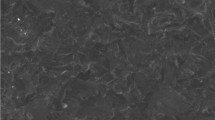Abstract
Cobalt–cobalt carbide [Co x C (x = 2 or 3)] and cobalt (FCC-Co) microwires have been synthesized using a polyol method in the presence of a high external magnetic field of 4.3 kOe. It was reported before that the synthesis of these particles in the absence of magnetic field leads to the formation of spherical particles. Analysis of the X-ray diffraction (XRD) scans indicates that the synthesized Co x C wires consist of four phases’ α-Co, β-Co, Co3C, and Co2C. The percent composition of these phases was 53.3 % Co3C, 26.8 % Co2C, 12.5 % α-Co, and 7.4 % β-Co. XRD analysis of the as-synthesized cobalt wires shows that it consists of single-phase FCC-Co. Based on Scherrer analysis of the XRD data, the average crystallite sizes of the cobalt carbide and the cobalt particles are 18.5 and 16.3 nm, respectively. Scanning electron microscopy (SEM) studies show that the diameter of Co x C wires is in the range of 1.6(±0.2) μm with their length varying between 18 and 30 μm while the diameter of the cobalt wires is 1.65(±0.1). The SEM results infer that the morphology of the growing particles was controlled by the magnetic field with the applied field directs the growth of the particles into wires. The magnetic measurements indicate a superparamagnetic character of the cobalt wires and a soft ferromagnetic nature of the synthesized Co x C chains. The degree and field range of the interactions between magnetic domains have been investigated using a Henkel plot.





Similar content being viewed by others
References
Carroll KJ, Reveles JU, Shultz MD, Khanna SN, Carpenter EE (2011) Preparation of elemental Cu and Ni nanoparticles by the polyol method: an experimental and theoretical approach. J Phys Chem C 115(6):2656–2664
Cha SI, Mo CB, Kim KT, Hong SH (2005) Ferromagnetic cobalt nanodots, nanorices, nanowires and nanoflowers by polyol process. J Mater Res 20(8):2148–2153
Cheng WT, Cheng HW (2009) Synthesis and characterization of cobalt nano-particles through microwave polyol process. AIChE J 55(6):1383–1389
Fert A, Piraux L (1999) Magnetic nanowires. J Magnetism Mag Mater 200(1–3):338–358
Fish GE (1990) Soft magnetic-materials. Proc IEEE 78(6):947–972
Harris VG, Chen Y, Yang A, Yoon S, Chen Z, Geiler AL et al (2010) High coercivity cobalt carbide nanoparticles processed via polyol reaction: a new permanent magnet material. J Phys D Appl Phys 43(16):1–7
Kamal SSK, Sahoo PK, Premkumar M, Rao NVR, Kumar TJ, Sreedhar B et al (2009) Synthesis of cobalt nanoparticles by a modified polyol process using cobalt hydrazine complex. J Alloys Compd 474(1–2):214–218
Kind H, Yan HQ, Messer B, Law M, Yang PD (2002) Nanowire ultraviolet photodetectors and optical switches. Adv Mater 14(2):158–160
Kyler JC, Zachary JH, Steven RS, Meichun Q, Shiv NK, Daniel MH et al (2012) Magnetic properties of Co2C and Co3C nanoparticles and their assemblies. Appl Phys Lett 101(1):012409–1012409-5
Osorio-Cantillo C, Santiago-Miranda AN, Perales-Perez O, Xin Y (2012) Size- and phase-controlled synthesis of cobalt nanoparticles for potential biomedical applications. J Appl Phys 111(7):07B324-1–07B324-3
Puntes VF, Krishnan KM, Alivisatos AP (2001) Colloidal nanocrystal shape and size control: the case of cobalt. Science 291(5511):2115–2117
Wang JF, Gudiksen MS, Duan XF, Cui Y, Lieber CM (2001) Highly polarized photoluminescence and photodetection from single indium phosphide nanowires. Science 293(5534):1455–1457
Whitney TM, Jiang JS, Searson PC, Chien CL (1993) Fabrication and magnetic-properties of arrays of metallic nanowires. Science 261(5126):1316–1319
Wohlfarth EP (1958) Relations between different modes of acquisition of the remanent magnetization of ferromagnetic particles. J Appl Phys 29(3):595–596
Yaacob II, Nunes AC, Bose A, Shah DO (1994) Synthesis and characterization of magnetic nanoparticles in spontaneously generated vesicles. J Colloid Interface Sci 168(2):289–301
Zhang YJ, Chaubey GS, Rong CB, Ding Y, Poudyal N, Tsai PC et al (2011) Controlled synthesis and magnetic properties of hard magnetic Co x C (x = 2, 3) nanocrystals. J Magnetism Mag Mater 323(11):1495–1500
Acknowledgments
A.A.F., Z.J.H., and E.E.C. would like to acknowledge the help of the Virginia Commonwealth Nanomaterials Core Characterization Facility. This study was funded by ARPAe.
Author information
Authors and Affiliations
Corresponding authors
Additional information
This article is part of the topical collection on nanomaterials in energy, health and environment
Rights and permissions
About this article
Cite this article
Farghaly, A.A., Huba, Z.J. & Carpenter, E.E. Magnetic field assisted polyol synthesis of cobalt carbide and cobalt microwires. J Nanopart Res 14, 1159 (2012). https://doi.org/10.1007/s11051-012-1159-z
Received:
Accepted:
Published:
DOI: https://doi.org/10.1007/s11051-012-1159-z




